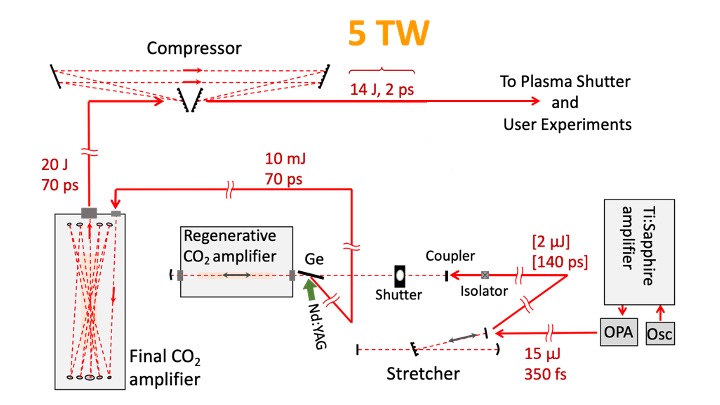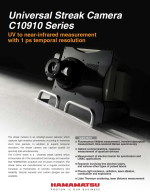- Home
- Capabilities
- Science Highlights
- Operations
- Publications
-
ES&H
- Experiment Start-up
- Laser Safety
Collider-Accelerator Dept.
- C-AD ES&H Resources
- Staff
- Users' Place
- Apply for Access
Laser Systems
The ATF offers both near infrared (NIR) and long-wave infrared (LWIR) capabilities for users. Each of these capabilities can be combined with the facility’s high brightness electron beam on the ATF electron beam lines. It is the only facility world-wide that offers users access to a terawatt- and picosecond-class LWIR laser system.
Laser Systems Capabilities:
LWIR Laser
The ATF's 5 terawatt and 2 picosecond LWIR (9.2 µm) carbon dioxide
laser is unique in the world. It is the first gas-based laser to utilize
chirped pulse amplification (CPA). With it, ATF users can explore the
long-wavelength scaling of various physical processes and new approaches
to particle acceleration and x-ray generation. A development program is
presently underway to further compress the beams to the sub-picosecond
level with the goal of delivering >10 TW and
< 0.5 ps to users within
the next 2-3 years. Typical operating parameters and
configurations for the LWIR laser system are summarized in Table 2.
Extensive diagnostics are available to characterize LWIR laser pulses.
These include: Joulemeters with up to 30 J maximum energy scale;
in-house constructed spectrometers; a custom autocorrelator; picosecond
streak camera; pyroelectric camera-based beam profile monitors;
nanosecond IR photodetectors and matching scopes; and focus imaging
set-ups for interaction point beam size analysis.

A dedicated laser-only experimental chamber is located in the “FEL” room.
Table 2 Typical operating parameters for the ATF LWIR laser system.
| Configuration | Parameter | Units | Typical Values | Comments |
|---|---|---|---|---|
| CO2 Regenerative Amplifier Beam | Wavelength | microns | 9.2 | Wavelength determined by mixed isotope gain media |
| Peak Power | GW | ~3 | ||
| Pulse Mode | --- | Single | ||
| Pulse Length | ps | 2 | ||
| Pulse Energy | mJ | 6 | ||
| M2 | --- | ~1.5 | ||
| Repetition Rate | Hz | 1.5 | 3 Hz also available if needed | |
| Polarization | --- | Linear | Circular polarization available at slightly reduced power | |
| CO2 CPA Beam Note that delivery of full power pulses to the EH is presently limited to Beam Line #1 only. |
Wavelength | microns | 9.2 | Wavelength determined by mixed isotope gain media |
| Peak Power | TW | 2 | ~5 TW operation is planned for FY21 (requires further in-vacuum transport upgrade). A 3-year development effort to achieve >10 TW and deliver to users is in progress. | |
| Pulse Mode | --- | Single | ||
| Pulse Length | ps | 2 | ||
| Pulse Energy | J | ~5 | Maximum pulse energies of >10 J will become available in FY20 | |
| M2 | --- | ~2 | ||
| Repetition Rate | HZ | 0.05 | ||
| Polarization | Linear | Adjustable linear polarization with circular polarization will become available in FY20 |
NIR Laser
The ATF offers a significant, and expanding, range of NIR laser capabilities for users as well. The facility’s Nd:YAG laser that drives the ATF’s RF photocathode gun can also provide beams for experiments. A new addition to the facility is a dedicated Ti:Sapphire experimental system that significantly expands the types of experiments that can be carried out. These beams are utilized both as drive beams for experiments and as diagnostics. Typical operating parameters for these systems are shown in Table 3. An extensive suite of NIR diagnostics are available at the facility. These include: single shot autocorrelators to <50 fs resolution; scanning autocorrelators to <40 fs resolution; a frequency resolved optical gating device at 800 nm to <100 fs resolution; picosecond streak cameras; high speed photodetectors to 50 GHz; real-time oscilloscopes up to 5 GHz; scanning oscilloscopes up to 50 GHz; a 1/4-meter imaging spectrometer; visible to 1.4 micron compact fiber-coupled spectrometers; power- and Joulemeters; CCD cameras; a wavefront sensor; as well as handheld IR viewers and conversion cards.
Table 3 Typical operating parameters for the ATF's NIR laser systems.
| NIR Laser System | Parameter | Units | Stage I Values | Stage II Values | Comments |
|---|---|---|---|---|---|
| Ti: Sapphire Laser System | Central Wavelength | nm | 800 | 800 | Stage I parameters have been delivered, while Stage II parameters will be available for user experiments once our vacuum transport installation is complete (now planned for FY21 after COVID-19 delays) |
| FWHM Bandwidth | nm | 20 | 13 | ||
| Compressed FWHM Pulse Width | fs | <55 | <75 | Transport of compressed pulses will initially include a very limited number of experimental interaction points. Please consult with the ATF Team if you need this capability. | |
| Chirped FWHM Pulse Width | ps | >50 | >50 | ||
| Chirped Energy | mJ | >30 | 200 | ||
| Compressed Energy | mJ | >14 | 100 | ||
| Energy to Experiments | mJ | >10 | >80 | ||
| Power to Experiments | GW | >250 | >1067 |
| NIR Laser System | Parameter | Units | Typical Values | 2021 Modifications | Comments |
|---|---|---|---|---|---|
| Nd:YAG Laser System | Wavelength | nm | 1064 | 1064 | Single Pulse |
| Energy | mJ | 5 | 100 | ||
| Pulse Width (FWHM) | ps | 14 | <20 | ||
| Wavelength | nm | 532 | --- | Frequency doubled | |
| Energy | mJ | 0.5 | --- | ||
| Pulse Width (FWHM) | ps | 10 | --- |
Laser Diagnostics
Streak Camera
The ATF has available a Hamamatsu universal streak camera 10910 (UV to near-IR with 1 ps temporal resolution) with the following options:
- A1974 refractive input optics
- S-20ER IR-enhanced photocathode
- M10912-01 fast single-sweep plug-in Custom CCD camera (ATF Basler scA1400-17gm)
Data acquisition is handled by the ATF frame grabber.





